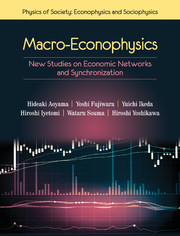Book contents
8 - Complex Networks, Community Analysis, Visualization
Summary
I read somewhere that everybody on this planet is separated by only six other people. Six degrees of separation. Between us and everybody else on this planet.
In a play written by John GuareAs pointed out in the Introduction, a macro economy consists of many micro agents. These agents are not independent of each other, but form networks, i.e., they have relationships among each other. An understanding of their interactions is crucial for an understanding of a macro economy.
This chapter explains the basic concepts and techniques for understanding the structure of economic networks, and then applies them to economic networks. Economic networks are not random nor regular, but exhibit fat-tailed distributions for the numbers and weights of relationships. They also form densely knit groups that are only loosely connected with each other, called clusters or communities.
Basic tools cover
• fundamental graph search algorithms that are applied to identify upstream and downstream in networks and also to model financial distress propagation
• a class of random networks used as a null model, namely a configuration model
• the concept of modularity derived from assortative mixing and the configuration model
• detection of communities by modularity and its extension
• visualization of large-scale networks by physical simulations in addition to other graph-theoretical tools. Applications include
• a nationwide production network comprising of a million firms and millions of supplier–customer relationships
• a community structure in correlation with the stock market found by the RMT and its extension
• a globally-coupled network of equities and currencies in the world found by the CHPCA method
• a world input–output database for countries and industrial sectors
• global production data for G7 countries
We will show that one can retrieve interesting information and implications by applying network analyses to these applications.
Basic Tools
Graph search and simple applications
Computational algorithms for simulation on a network are often based on graph-search algorithms and their modifications. Graph search refers to a way of visiting nodes and/or edges exhaustively by putting “marks” on them in a systematic manner. It is analogous to the well-known Greek tale about the hero, Theseus, who successfully escaped from a labyrinth of Minotaur by following Ariadne's thread, but is far more elaborate.
Information
- Type
- Chapter
- Information
- Macro-Econophysics , pp. 225 - 305Publisher: Cambridge University PressPrint publication year: 2017
